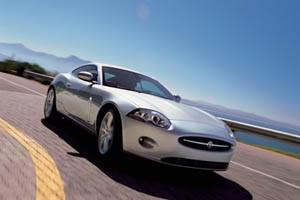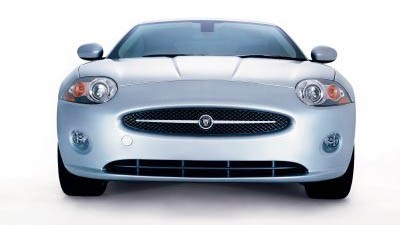Jaguar is proud to announce a new era in its sports car lineage – the all-new XK. Like all Jaguar sports cars, the focus of the all-new XK is firmly on the future, while acknowledging the marque’s rich history. It heralds a new era for Jaguar in terms of both design and engineering, and it is the most technically advanced Jaguar ever built.
 POWERTRAINS
POWERTRAINS
From launch, the all-new XK will be powered by Jaguar’s renowned naturally aspirated 4.2L V8 engine, which produces 300bhp SAE (298 PS EEC). This compact, lightweight engine has undergone significant development compared with the engine used in the previous XK, including new fuel-injection technology. The latest 4.2L engine satisfies Euro 4 emissions requirements as well as stringent U.S. emissions regulations.
The 4.2L V8 develops maximum torque of 303 lb.-ft. (411 Nm) EEC at 4,100 rpm. Again, the spread of torque is an important ingredient in the XK’s effortlessly sporty character, and this engine delivers more than 85 percent of torque, all the way from 2,000 to 6,000 rpm. Yet it still offers fine fuel economy and low emissions figures, with a drop in CO2 emissions of 6 percent (manufacturer provisional test figures).
The naturally aspirated 4.2L V8 XK coupe has an electronically limited maximum speed of 155 mph and a 0-60 mph time of 5.9 seconds, plus instant throttle response and broad flexibility for punchy performance across the range. With the all-new XK’s weight savings, the new naturally aspirated 4.2’s standing quarter-mile time of 14.4 seconds is less than half a second off the pace of the previous supercharged 4.2 XKR (manufacturer provisional test figures).
For the first time in a Jaguar, drivers will be able to use steering wheel-mounted paddles to change gears with the new Jaguar Sequential Shift transmission. In either Drive or Sport Manual modes, very fast gear shifts are achieved by combining the use of one-touch paddles with an automatic blip of the throttle from the drive-by-wire engine management system during downshifts. Thanks to this positive torque enhancement control, the shifts are faster and more responsive than before regardless of the mode the driver has selected.
The XK’s six-speed transmission introduces a new generation of automatic gearshift for Jaguar, replacing the familiar “J” gate with the new Jaguar Sequential Shift system with Park, Reverse, Neutral, Drive and Sport modes. The fully automatic Drive mode adapts to individual driving styles, while a Sport Auto mode can also be selected. This offers an even more responsive fully automatic shift strategy, also utilizing the automatic blip of the throttle to maintain ultra-smooth gear shifts (manufacturer provisional test figures).
TECHNOLOGY
The all-new XK has a completely new, high-performance braking system, tested extensively over many hundreds of laps at the gruelling Nurburgring test track in Germany, where Jaguar has a dedicated research facility. The result is greater braking power and more responsive feedback to the enthusiastic driver.
Larger, ventilated discs contribute to better pedal feel, optimum stopping distances and resist fade during extended hard use. The braking system also includes four-channel ABS, electronic brake force distribution, hydraulic brake assist to increase brake pressure during an emergency stop, and Jaguar’s electronic park brake function.
Unlike conventional digital ABS systems used on many cars, the all-new XK’s ABS system can vary the brake pressure at each wheel using analogue valves in the hydraulic control unit. This gives more refinement to the hydraulic pressure control and allows drivers to benefit from increased steering input during heavy braking.
The all-new XK’s Servotronic 2 steering is adapted for a sports car from the XJ saloon, to give easy low-speed maneuvering with optimum high-speed feedback under all conditions.
The XK includes a host of safety features. These include the option of a tire pressure monitoring system and run-flat tires, Jaguar’s Protec dynamic headrest system to protect against whiplash injuries, Forward Alert which uses the optional Adaptive Cruise Control’s forward-facing sensors to scan the road ahead 10 times every second to warn of a potential collision, and the new switchable Dynamic Stability Control with Traction Control System (Trac DSC).
A new active front lighting system is also offered as an option on the XK, enhancing the bi-xenon intelligent lighting that is standard on the car. This feature provides enhanced visibility in the dark during higher speed cornering by swivelling the dipped beam lens depending on road speed and the angle at which the steering wheel is turned.






